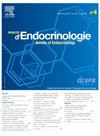第四章:原发性甲状旁腺功能亢进的鉴别诊断。
IF 2.9
3区 医学
Q3 ENDOCRINOLOGY & METABOLISM
引用次数: 0
摘要
原发性甲状旁腺功能亢进的鉴别诊断可以从临床、生物学和放射学上考虑。临床上,如有弥漫性疼痛、肾结石、骨质疏松、反复骨折、认知或精神障碍、意识障碍,应怀疑原发性甲状旁腺功能亢进。然而,原发性甲状旁腺功能亢进症的鉴别诊断主要是生物学上的,尤其是不典型的,一方面必须与高钙血症合并低钙尿症或无PTH增高,另一方面必须与正常钙血症合并PTH增高、低磷血症或高钙尿症鉴别。任何鉴别诊断必须在分析可能干扰磷钙参数的因素之前进行:维生素D缺乏(测定)、肾功能不全(eGFR测量)、吸收不良(消化道炎性疾病、乳糜泻、减肥手术等)、钙摄入不足(GRIO问卷)和医源性原因(利尿剂、抗骨质疏松药物、过量维生素D或钙补充、锂、皮质类固醇治疗、磷摄入)。一旦这些因素被排除,高钙血症伴低钙尿症应提示遗传原因。高钙血症伴非PTH升高可能继发于肿瘤、维生素D过多症(过量摄入、产生或分解代谢)、固定或内分泌原因。无高钙血症的甲状旁腺激素升高必须与正常钙血症的甲状旁腺功能亢进相鉴别。高甲状旁腺激素水平见于甲状旁腺激素抵抗患者,以及低磷血症(尤其是x连锁)或高钙血症小管病(某些罕见疾病,固定化,利尿剂或特发性原因有利于代谢综合征)。放射学上,棕色肿瘤必须首先与骨转移、软骨肉瘤和巨细胞瘤鉴别。本文章由计算机程序翻译,如有差异,请以英文原文为准。
Chapter 4: Differential diagnosis of primary hyperparathyroidism
The differential diagnosis of primary hyperparathyroidism can be considered clinically, biologically and radiologically. Clinically, primary hyperparathyroidism should be suspected in case of diffuse pain, renal lithiasis, osteoporosis, repeated fracture, cognitive or psychiatric disorder, or disturbance of consciousness. Nevertheless, the differential diagnosis of primary hyperparathyroidism is mainly biological, particularly in atypical forms, which must be differentiated from hypercalcemia with hypocalciuria or non-elevated PTH on the one hand, and from normo-calcemia with elevated PTH, hypophosphatemia or hypercalciuria on the other. Any differential diagnosis must be preceded by an analysis of the factors likely to disturb phospho-calcium parameters: vitamin D deficiency (assay), renal insufficiency (eGFR measurement), malabsorption (inflammatory disease of the digestive tract, celiac disease, bariatric surgery, etc.), insufficient calcium intake (GRIO questionnaire) and iatrogenic causes (diuretics, anti-osteoporotic drugs, excessive vitamin D or calcium supplementation, lithium, corticosteroid therapy, phosphorus intake). Once these factors have been eliminated, hypercalcemia with hypocalciuria should suggest a genetic cause. Hypercalcemia with non-elevated PTH may be secondary to neoplasm, hypervitaminosis D (excessive intake, production or catabolism), immobilization or endocrine causes. Elevated PTH values without hypercalcemia must be differentiated from normo-calcemic hyperparathyroidism. High PTH levels are found in PTH-resistant patients, as well as in hypophosphatemic (especially X-linked) or hypercalciuric tubulopathies (certain rare diseases, immobilization, loop diuretics or idiopathic causes favored by a metabolic syndrome). Radiologically, brown tumor must be differentiated primarily from bone metastasis, chondrosarcoma and giant cell tumor.
求助全文
通过发布文献求助,成功后即可免费获取论文全文。
去求助
来源期刊

Annales d'endocrinologie
医学-内分泌学与代谢
CiteScore
4.40
自引率
6.50%
发文量
311
审稿时长
50 days
期刊介绍:
The Annales d''Endocrinologie, mouthpiece of the French Society of Endocrinology (SFE), publishes reviews, articles and case reports coming from clinical, therapeutic and fundamental research in endocrinology and metabolic diseases. Every year, it carries a position paper by a work-group of French-language endocrinologists, on an endocrine pathology chosen by the Society''s Scientific Committee. The journal is also the organ of the Society''s annual Congress, publishing a summary of the symposia, presentations and posters. "Les Must de l''Endocrinologie" is a special booklet brought out for the Congress, with summary articles that are always very well received. And finally, we publish the high-level instructional courses delivered during the Henri-Pierre Klotz International Endocrinology Days. The Annales is a window on the world, keeping alert clinicians up to date on what is going on in diagnosis and treatment in all the areas of our specialty.
 求助内容:
求助内容: 应助结果提醒方式:
应助结果提醒方式:


